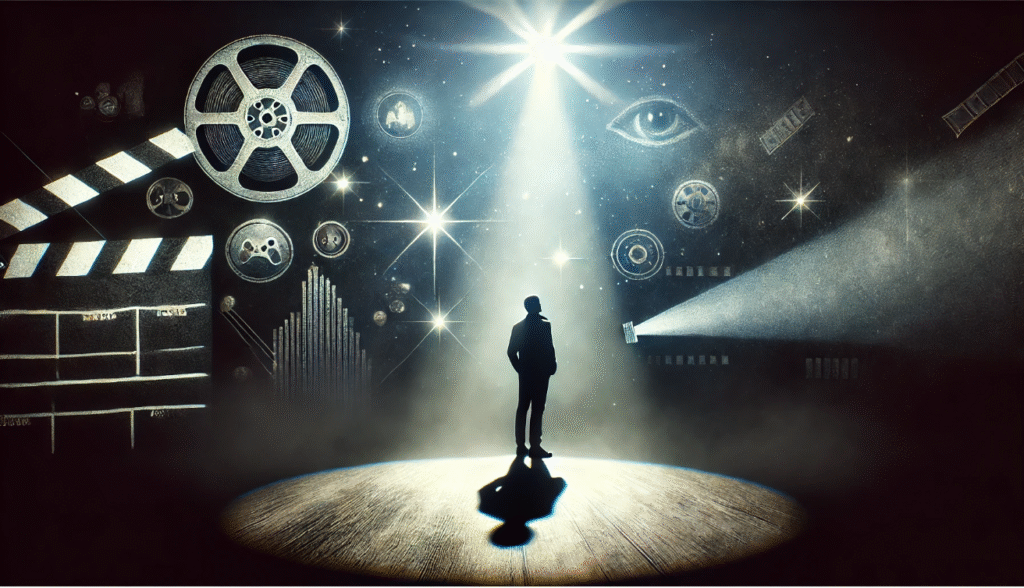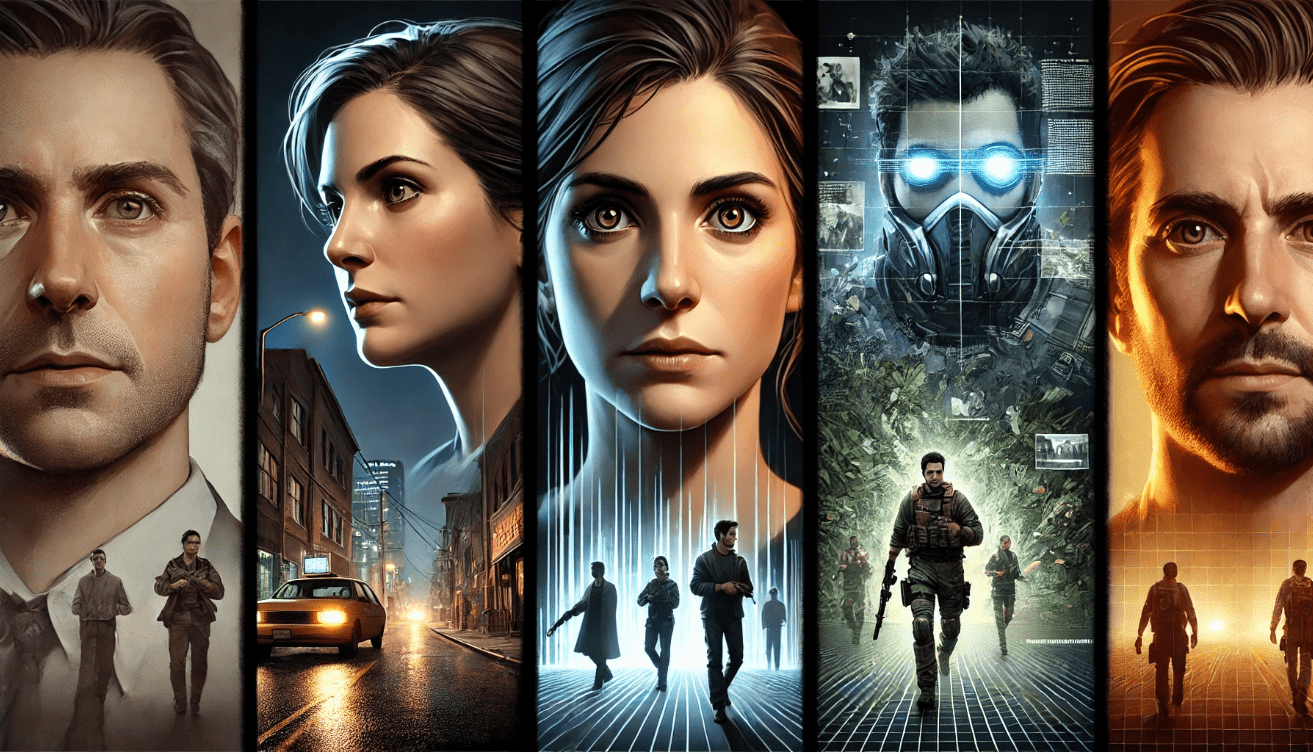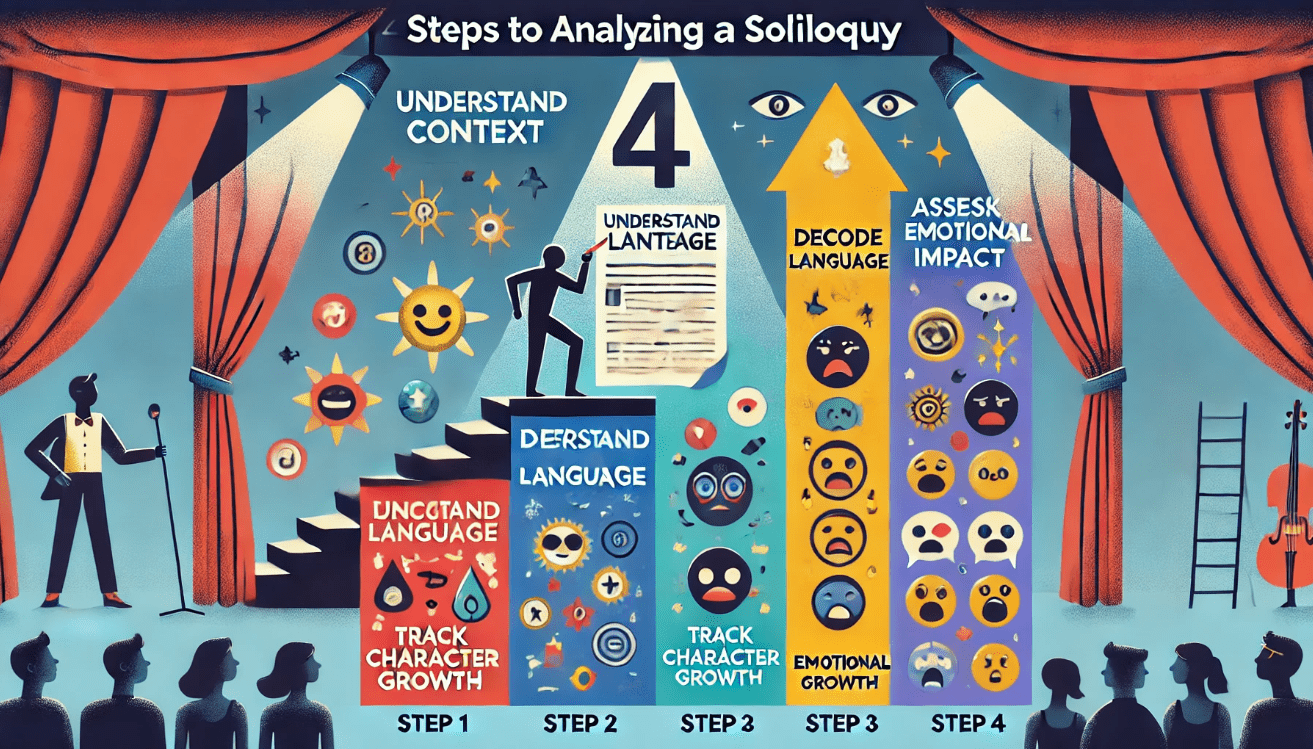
How Soliloquies Shape Character Arcs: Unlocking Deeper Storytelling
Imagine Hamlet’s voice echoing, “To be or not to be,” revealing his deepest fears and doubts. Soliloquies like this captivate us, but why? They unlock a character’s soul, making stories unforgettable. If you’ve ever wondered how writers create characters that feel alive or struggled to understand their inner journeys, you’re not alone. This article explores the role of soliloquies in character arcs, offering clear, beginner-friendly insights to deepen your storytelling or analysis. Discover how soliloquies transform narratives and connect you to characters like never before! 😊
Table of Contents
Toggle1: What Is a Soliloquy and Why Does It Matter? 😊
A soliloquy is a dramatic moment where a character speaks their thoughts aloud, alone on stage or screen, sharing their inner world with the audience. Think of Hamlet pondering life and death in “To be or not to be.” It’s raw, unfiltered, and powerful.

Key Features of a Soliloquy:
- Spoken by one character, usually alone.
- Reveals true emotions, conflicts, or plans.
- Common in plays like Shakespeare’s, but also in modern films and TV.
Why Soliloquies Matter:
They let you peek into a character’s mind, building empathy and making their journey relatable. For writers, they’re a tool to show complex feelings without extra dialogue. For readers or viewers, they make stories unforgettable.
02.How Soliloquies Drive Character Arcs 😊

Soliloquies are like a window into a character’s soul, showing their growth, struggles, and pivotal moments. They make characters feel real and relatable, driving their arcs in ways dialogue alone can’t. Here’s how they work their magic.
Revealing Inner Conflict
Soliloquies expose a character’s deepest struggles. For example, Hamlet’s “To be or not to be” soliloquy lays bare his indecision about life and revenge. This inner turmoil shapes his tragic arc, making his choices gripping.
Marking Transformation Points
A soliloquy often signals a turning point. In Macbeth, the “Is this a dagger?” speech shows Macbeth’s ambition taking over, pushing him toward villainy. These moments highlight how characters change.
Building Audience Connection
By sharing raw emotions, soliloquies create empathy. Lady Macbeth’s “Out, damned spot!” reveals her guilt, making her descent human and heartbreaking. You feel her pain, rooting for or mourning her.
Practical Tip: Next time you read or watch a play, note how a soliloquy changes your view of the character. Try sketching their arc before and after to see the shift!
03.Why Soliloquies Are Essential for Storytelling 🌟
Soliloquies are storytelling superpowers. They bring characters to life, push the plot forward, and leave lasting impressions. Whether you’re a writer, student, or theater fan, understanding their role makes stories more engaging. Here’s why soliloquies are a must.
Deepening Emotional Connections
Soliloquies let audiences feel a character’s raw emotions. When Hamlet questions life in “To be or not to be,” you connect with his vulnerability. This intimacy makes characters unforgettable and relatable.
Driving the Plot Forward
Soliloquies often reveal plans or decisions that shape the story. In Othello, Iago’s solo speeches expose his schemes, propelling the tragedy. They’re like plot engines, moving the narrative smoothly.
Creating Memorable Moments
Iconic soliloquies stick with us. Romeo’s “But, soft! What light through yonder window breaks?” captures love’s intensity, becoming a cultural gem. These moments make stories timeless.
Practical Tip: Watch a favorite movie or show and spot soliloquy-like moments (like voiceovers). Note how they make you care about the character or story more. Try writing one to test their power! ✍️
04.How to Analyze Soliloquies Like a Pro 📝
Want to unlock the secrets of a character’s mind? Analyzing soliloquies is your key! This beginner-friendly guide breaks down how to study soliloquies to understand characters and stories better. Follow these steps to feel like a storytelling expert.
Understand the Context
Start by asking: What’s happening in the story? Why is the character alone? For example, in Hamlet’s “To be or not to be,” he’s wrestling with life and death after learning of his father’s murder. Context reveals why the soliloquy matters.
Decode the Language
Look at the words closely. Notice metaphors, tone, and imagery. In Macbeth’s “Is this a dagger?” soliloquy, the dagger symbolizes his ambition. Simple language clues like these unpack the character’s emotions and motives.
Track the Character’s Growth
How does the soliloquy show change? Hamlet’s speech marks his shift from indecision to action. Compare the character’s thoughts before and after to see how the soliloquy shapes their arc.
Assess the Audience Impact
Think: How does this make you feel? A soliloquy like Lady Macbeth’s “Out, damned spot!” evokes pity for her guilt. This emotional pull deepens your connection to the story.
Practical Tip: Keep a notebook to jot down context, language, and feelings for each soliloquy you read or watch. Try analyzing Hamlet’s famous speech to practice! 😊
05.Writing Soliloquies: Practical Tips for Aspiring Writers ✍️
Want to make your characters leap off the page? Soliloquies are a powerful way to reveal their inner world and captivate readers. This beginner-friendly guide offers actionable tips to craft soliloquies that deepen your storytelling, even if you’re just starting out.
Match the Character’s Voice
Ensure the soliloquy sounds like your character. A teenager might use casual slang, while a king speaks formally. For example, a modern hacker might say, “Do I leak this data or play it safe?” Keep it authentic to their personality.
Focus on a Key Moment
Use soliloquies for pivotal conflicts or decisions. A character debating whether to confess a secret or betray a friend creates drama. Pinpoint a moment that shifts their arc, like Macbeth’s ambition in “Is this a dagger?”
Keep It Concise and Emotional
Short, punchy soliloquies hit harder. Aim for raw emotion—fear, hope, or anger. Avoid rambling; every word should reveal something deep. Read it aloud to check if it flows naturally and grips the reader.
Test with a Modern Example
Try writing a soliloquy for a character like a nurse facing a moral dilemma: “Do I report this mistake, or protect my team?” This exercise helps you practice revealing stakes and emotions clearly.
Practical Tip: Write a short soliloquy for a character in your story. Read it aloud to ensure it feels real. Share it with a friend for feedback on its emotional impact! 😊
06.🎬 Soliloquies in Modern Media: From Stage to Screen
Soliloquies aren’t just relics of Shakespearean theatre—they’re powerful storytelling tools still used in today’s films, TV shows, and even video games. They allow characters to speak directly to the audience, revealing their raw thoughts, fears, and motivations. This unique peek behind the curtain can shape character arcs in meaningful ways—if used right. Let’s break it down. 👇
🎭 What Is a Soliloquy, Really?
A soliloquy is when a character speaks their inner thoughts out loud, typically alone on stage or in a scene. It’s not small talk or dialogue—it’s deep, personal, and usually intended for the audience’s ears only.
In modern media, this tradition has evolved, showing up in clever and creative ways—think internal monologues, voice-overs, or “breaking the fourth wall.”
🎥 Soliloquies on Screen: Real Examples You Know
Modern storytellers have reimagined soliloquies across formats:

- TV Shows: Fleabag masterfully breaks the fourth wall. When the main character turns to the camera, we’re inside her head—experiencing her pain, humor, and vulnerability in real time.
- Films: In Fight Club, the narrator (played by Edward Norton) uses voice-over narration as a form of internal soliloquy, pulling the viewer into his unraveling mind.
- Video Games: Titles like The Last of Us and God of War use in-game soliloquies or reflective dialogues to deepen emotional impact without breaking immersion.
These aren’t just “cool moments”—they build trust, deepen character arcs, and make us feel more connected. 🎯
🧠 Why Soliloquies Still Matter Today
Soliloquies serve one major purpose: they unlock emotional clarity. In an era of fast-paced storytelling, pausing for a character’s inner world creates contrast and depth.
Here’s how they enhance character arcs:
- Reveal inner conflict: Show what the character really thinks vs. what they show others.
- Foreshadow growth: Offer a glimpse of who the character might become.
- Deepen empathy: Let the audience relate to flaws, fears, and hopes.
When used effectively, a soliloquy can turn a plot twist into a heart punch. 💥
✅ How Writers Can Use Soliloquies Effectively
Whether you’re writing a screenplay, novel, or game script, here’s how to make soliloquies work for you:
- Make it personal – Speak from the heart of the character, not the writer’s brain.
- Keep it brief but bold – A few sharp lines can hit harder than a long rant.
- Use contrast – Show how the character behaves vs. what they say to themselves.
- Match the medium – Use voice-overs for film, camera glances for TV, and reflective narration in games.
- End with purpose – Let the soliloquy change something: a decision, a perspective, or even the next scene.
Think of it as a mini-mirror for your character—one that reveals their true self, even when they can’t.
🚀 Final Takeaway: Soliloquies Are Secret Storytelling Superpowers
Soliloquies have moved from center stage to the screens in our pockets, but their core function hasn’t changed—they’re windows into the soul.
Done right, they:
- Strengthen emotional storytelling 💔
- Clarify character development arcs 🧩
- Create memorable, binge-worthy moments 📺
So next time you’re crafting a story, ask: What does this character wish they could say out loud? That’s where your soliloquy lives. 🎤
⚠️ Common Mistakes When Interpreting Soliloquies (And How to Avoid Them)

Soliloquies can be goldmines for understanding characters—but only if interpreted correctly. Whether you’re a writer, actor, student, or content creator, misreading a soliloquy can lead to shallow storytelling or missed emotional depth.
Here are the most common pitfalls people make when interpreting soliloquies—and how you can avoid them. 👇
1: Taking the Words at Face Value
The Problem:
Soliloquies often express raw emotion, but they’re not always meant to be factual. Characters may be confused, exaggerating, or even lying to themselves.
How to Avoid It:
Look deeper than the literal meaning. Ask:
- What is this character afraid to admit?
- What do they want the audience to believe?
💡 Pro Tip: Emotions like guilt, jealousy, or fear often hide behind confident words.
2: Ignoring the Emotional Subtext
The Problem:
Focusing only on the words and missing the feeling behind them can make your interpretation fall flat.
How to Avoid It:
Pay attention to tone, rhythm, and pauses. What emotions are bubbling under the surface? Try reading the soliloquy aloud and notice where your voice naturally shifts.
🎭 Think: What would this sound like if it were a voiceover in a modern drama?
3: Treating Soliloquies Like Speeches
The Problem:
A soliloquy isn’t a public speech—it’s an intimate thought process. Interpreting it as a formal monologue can rob it of vulnerability.
How to Avoid It:
Approach it like an overheard thought, not a performance. The character is speaking to themselves—or the audience—as if no one else is watching.
🔍 Imagine you’re inside the character’s mind, not on stage with them.
4: Missing the Context
The Problem:
Soliloquies don’t happen in a vacuum. Interpreting them without understanding what came before or after can lead to confusion.
How to Avoid It:
Always ask:
- What just happened to trigger this soliloquy?
- What decision or shift does it lead to?
📚 Whether you’re analyzing Hamlet or a voiceover in a modern film, context is everything.
5: Overacting or Overanalyzing
The Problem:
Sometimes people get so caught up in “drama” or symbolism that the soliloquy loses its human touch.
How to Avoid It:
Keep it real. Treat the soliloquy like an emotional journal entry. What would this moment feel like if you were in their shoes?
😌 Simplicity often delivers more power than over-the-top delivery or reading too much into every word.
✅ Quick Checklist: How to Interpret a Soliloquy the Right Way
✔️ Know the context (what happened before and after)
✔️ Understand the emotion behind the words
✔️ Question the reliability of the speaker
✔️ Treat it as private thought, not public speech
✔️ Keep it human and relatable 💬
💬 Final Thought: Let Soliloquies Speak To You
Soliloquies are not puzzles to be solved—they’re windows into the soul. When you stop trying to decode every line and start listening with empathy, you unlock the real magic. 💖
Whether you’re interpreting Shakespeare, crafting dialogue for a script, or analyzing a TV character’s voiceover, remember: what’s unsaid is often just as important as what’s spoken. 🎤
Unlocking the Power of Soliloquies in Storytelling
Soliloquies aren’t just old-school monologues from dusty plays—they’re timeless tools that reveal the heart of a character. From stage to screen, they’ve evolved into voiceovers, inner thoughts, and direct audience asides that pull us deeper into a story. 🎬💬
When used effectively, soliloquies:
- Add emotional depth to characters 🧠
- Drive meaningful character arcs 🎯
- Create intimate, unforgettable moments for the audience 💥
But the real magic? It happens when we interpret them with empathy, context, and curiosity—not just as lines, but as emotional truths.
🚀 Final Takeaway: Let Soliloquies Work For You

Whether you’re a writer building authentic dialogue, an actor preparing a role, or a creator analyzing great storytelling—soliloquies can be your secret weapon.
So ask yourself:
👉 What is my character too afraid to say out loud?
👉 What truth are they only willing to share with the audience—or themselves?
That’s your story’s emotional core. Tap into it, and you’ll connect with your audience on a whole new level. 💡
Frequently Asked Questions (FAQs)
1. What is a soliloquy in storytelling?
A soliloquy is when a character speaks their inner thoughts out loud, usually to themselves or directly to the audience. It reveals what they truly think or feel, helping the audience understand their motivations and emotions.
2. How do soliloquies shape a character arc?
Soliloquies show a character’s internal struggles, decisions, and emotional growth over time. By hearing their unfiltered thoughts, the audience sees how the character changes from the inside out.
3. What’s the difference between a soliloquy and a monologue?
A soliloquy is a private moment—spoken alone or directly to the audience—while a monologue can be addressed to other characters. Soliloquies focus more on revealing inner truth, not just speaking for dramatic effect.
4. Can soliloquies be used in modern stories or screenwriting?
Yes! Modern films, TV shows, and even video games use soliloquies through voiceovers, internal monologues, or “breaking the fourth wall.” It’s a great way to build emotional connection with the audience.
5. Why are soliloquies important for emotional storytelling?
Soliloquies let the audience hear what a character won’t say out loud, making the story feel more personal and relatable. They create deeper emotional impact and help viewers understand the why behind a character’s actions.
6. What are common mistakes when writing soliloquies?
Some writers make them too long, too formal, or out of character. A strong soliloquy should feel natural, emotionally honest, and reveal something new about the character.
7. How can I tell if a soliloquy is working in my story?
If the soliloquy reveals something important, moves the story forward, or changes how we see the character, it’s doing its job. It should feel necessary, not like filler.
8. Should every story include a soliloquy?
Not necessarily. Soliloquies work best when a story needs emotional depth or a clearer window into a character’s mind. If it adds value and insight, it’s worth including.
